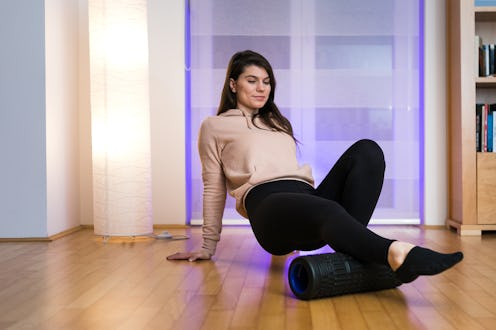Fitness
Should You Foam Roll Before Or After Your Workout? Experts Explain
It'll do different things to your body.

If you own a foam roller as part of your workout gear, you aren’t alone. According to a OnePoll survey commissioned by Dymatize, 34% of exercisers like to use the muscle massaging tool as part of their pre-or post-workout routine. But it isn’t always clear which one is the better choice: Should you foam roll before or after a workout?
What is clear, however, is that foam rolling is an effective way to reduce stress and tension in your body, says Steve Hruby, a doctor of chiropractic and founder of Kaizen Progressive Health. “It's also a great way to increase your flexibility, relieve pain, and improve your range of motion,” he tells Bustle. Foam rolling is essentially the act of gliding your body over a dense piece of foam or plastic designed to apply pressure to your muscles, explains Kurt Roeser, PT, DPT, OCS, a board-certified orthopedic specialist and official physical therapist of On Athletics Club (OAC). One way it works is by stimulating your central nervous system. “Massage creates a relaxation response in the body through a complex series of chemical, hormonal, and electrical changes resulting in the ability to move better,” Roeser tells Bustle.
It also benefits the muscle tissue directly in two ways: via mechanical movement and fluid movement. “Mechanical movement is simply the smashing, stretching, or releasing of fascia and muscle layers to allow for improved mobility,” says Roeser. “This is probably the concept most of us are familiar with.” Then there’s fluid movement, aka the idea that foam rolling may help improve blood flow, lymphatic return, and the diffusion of fluid and nutrients through pressure and movement, he adds. In short, it’s a great addition to a workout routine. But the question remains: When exactly should you do it?
Should You Foam Roll Before Or After Workouts?
According to Roeser, when you foam roll depends on your goals and personal preference. You might, for instance, find that you prefer to roll before a workout as a way to warm up your muscles. In that case, he suggests spending five to 10 minutes rolling major muscle groups that feel tight to prepare your body for the activity you’re about to perform. Going for a run? Focus on your hamstrings, calves, and glutes so that you’re ready to go.
If your goal is to prevent sore muscles, rolling after your workout may feel better. “I like to think of foam rolling as an [affordable substitute] for a professional massage,” says Megan Henry, a 200-hour registered yoga teacher at Island Retreat. “It can be a great addition to post-workout stretches, particularly for targeting large muscles or muscle groups like the glutes, back, and legs.” In fact, studies have shown that foam rolling may be effective in preventing delayed onset muscle soreness (DOMS).
The good thing, though, is it’s totally OK to hit up your roller before and after your workout session. Try foam rolling before a workout to loosen up tight muscles so they’re primed for movement, then again afterward to stave off soreness and keep your muscles feeling more limber. As Hruby says, it’s entirely up to you to experiment and figure out what works best for your body.
How Often To Foam Roll
Consistency is key when it comes to seeing the full benefits of foam rolling. Roeser suggests rolling two to three times a week for about five to 10 minutes each time. “Work on each muscle group for about a minute then move on,” he says. “You'll feel better and notice an improved range of motion after a couple of weeks.”
If you don’t have time to roll your entire body, aim for the spots you’re about to use in your workout, or any areas that feel the most prone to tightness afterwards. “Don't feel like you have to work your whole body every time,” he says. If you want to foam roll your calves after a long run, do that. If your back feels stiff when you get to the gym, focus your attention there.
Foam Rolling Routine
To make the most of your foam rolling session, Hruby suggests rolling smoothly at a moderate pace, using consistent pressure, and breathing deeply throughout. With that in mind, try the routine above, or follow the guidelines below to get started.
- Start by foam rolling your calves, rolling slowly on tight or sore spots for 30 seconds.
- Move up to your thighs, then hamstrings, then glutes, Hruby says.
- You can also roll your upper back, shoulders, and neck. Roeser suggests leaning back over the roller for a thoracic extension.
- Spend extra time on the areas that feel especially tight, aiming to roll for about five to 10 minutes total.
- Once you've rolled all of your muscles that need attention, spend a few minutes stretching.
Studies referenced:
Adamczyk, J. 2020. Does the type of foam roller influence the recovery rate, thermal response and DOMS prevention?. PloS one. https://doi.org/10.1371/journal.pone.0235195.
Cheatham, S. The effects of self‐myofascial release using a foam roll or roller massager on joint range of motion, muscle recovery, and performance: a systematic review. Int J Sports Phys Ther. https://www.ncbi.nlm.nih.gov/pmc/articles/PMC4637917/
Junker, DH. 2015. The Foam Roll as a Tool to Improve Hamstring Flexibility. J Strength Cond Res. doi: 10.1519/JSC.0000000000001007.
Kerautret, Y. 2021 Foam Rolling Elicits Neuronal Relaxation Patterns Distinct from Manual Massage: A Randomized Controlled Trial. Brain sciences. https://doi.org/10.3390/brainsci11060818.
Pearcey, G. 2015. Foam rolling for delayed-onset muscle soreness and recovery of dynamic performance measures. Journal of athletic training. https://doi.org/10.4085/1062-6050-50.1.01.
Sources:
Steve Hruby, doctor of chiropractic
Kurt Roeser, PT, DPT, OCS, board-certified orthopedic specialist, physical therapist
Megan Henry, yoga teacher